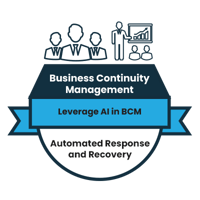The Role of AI in Business Continuity Management: Automating Response and Recovery
In today’s fast-paced and unpredictable business environment, organisations face many risks— from cyberattacks and natural disasters to supply chain disruptions and pandemics.
Ensuring business continuity in such challenges is critical, and artificial intelligence (AI) is emerging as a transformative tool to enhance resilience.
Organisations can mitigate disruptions and recover by deploying AI for automated response and recovery.
Two key areas AI significantly impacts are dynamic playbooks and resource allocation, enabling businesses to respond to incidents swiftly and precisely.
Automated Response and Recovery: The AI Advantage
Traditional business continuity management (BCM) often relies on static, pre-defined plans that may not account for each incident's unique complexities.
AI, however, introduces a dynamic and adaptive approach to response and recovery.
By leveraging machine learning, natural language processing, and predictive analytics, AI systems can analyse real-time data, identify patterns, and generate tailored solutions to address specific disruptions.
Dynamic Playbooks: Tailored Response Plans for Every Incident
One of the most powerful applications of AI in BCM is the creation of dynamic playbooks.
Unlike static plans, which are often generic and inflexible, AI-generated playbooks are tailored to the specific nature of an incident.
For example, in a logistics breakdown, AI can analyse the disruption’s scope, assess alternative routes, and generate a response plan that includes rerouting supply chains, reallocating transportation resources, and communicating with stakeholders.
AI systems can integrate data from multiple sources—such as IoT sensors, weather forecasts, and market trends—to create proactive and reactive playbooks.
For instance, if a hurricane is predicted to disrupt operations in a specific region, AI can pre-emptively generate a playbook that outlines steps to secure facilities, relocate inventory, and adjust production schedules.
This level of customisation ensures that organisations are prepared for disruptions and can execute recovery strategies with minimal downtime.
Resource Allocation: Optimizing Decisions During Crises
Effective resource allocation is a cornerstone of business continuity, yet it is often challenging to achieve during a crisis.
AI-driven decision-making tools can optimise the allocation of personnel, inventory, and financial resources in real-time, ensuring that critical operations remain functional.
For example, during a cyberattack, AI can analyse the impact on IT systems, prioritise restoring essential services, and allocate technical staff to the most urgent tasks.
AI can also optimise inventory management during supply chain disruptions. By analysing historical data, current demand, and supplier availability, AI systems can recommend adjustments to inventory levels, identify alternative suppliers, and even predict future shortages.
This capability is particularly valuable in industries with complex supply chains, such as manufacturing and retail, where delays can have cascading effects on operations.
AI can help organizations manage cash flow and prioritize expenditures during a crisis in financial resource allocation.
By analysing financial data and market conditions, AI can recommend cost-saving measures, identify areas where spending can be deferred, and ensure that funds are directed toward critical recovery efforts.
Implementing AI for Business Continuity: Key Considerations
While the benefits of AI in BCM are clear, successful implementation requires careful planning and execution.
Here are some key considerations for organisations looking to deploy AI for automated response and recovery:
- Data Integration and Quality: AI systems rely on accurate and comprehensive data to generate effective playbooks and resource allocation strategies. Organisations must ensure that data from various sources—such as ERP systems, IoT devices, and external databases—is integrated and up to date.
- Scalability and Flexibility: AI solutions must be scalable to handle incidents of varying magnitudes and flexible enough to adapt to evolving threats. Cloud-based AI platforms can provide the necessary scalability and flexibility.
- Human-AI Collaboration: While AI can automate many aspects of response and recovery, human oversight remains essential. Organizations should establish clear protocols for collaboration between AI systems and human decision-makers.
- Ethical and Regulatory Compliance: The use of AI in BCM must comply with ethical guidelines and regulatory requirements, particularly regarding data privacy and security.
- Continuous Learning and Improvement: AI systems should be designed to learn from past incidents and improve over time. Regular updates and refinements to AI models will ensure that they effectively address new and emerging risks.
Summing Up …
AI is revolutionising business continuity management by enabling automated response and recovery through dynamic playbooks and optimised resource allocation.
By leveraging AI, organisations can respond to disruptions with greater speed, precision, and adaptability, minimising downtime and ensuring operational resilience.
As the business landscape evolves, AI will play an increasingly vital role in helping organisations navigate uncertainty and maintain continuity in adversity.
Embracing AI-driven BCM is not just a competitive advantage but a necessity for thriving in an unpredictable world.
| Ensuring Continuity: BCM Best Practices for Frasers Property | |||||
| C1 | C2 | C3 | C4 | C5 | C6 |
 |
 |
 |
 |
 |
 |
| C7 | C8 | C9 |
C10 |
C11 |
C12 |
 |
 |
 |
 |
 |
 |
| C13 | C14 | C15 | C16 | C17 | C18 |
 |
 |
 |
 |
 |
 |
More Information About Business Continuity Management Courses




![Register [BL-B-3]*](https://blog.bcm-institute.org/hs-fs/hubfs/hub_generated/resized/19a8306f-6b76-45ff-8585-95111f393aeb.png?width=200&height=56&name=19a8306f-6b76-45ff-8585-95111f393aeb.png)



![FAQ [BL-B-3]](https://blog.bcm-institute.org/hs-fs/hubfs/hub_generated/resized/9b7f5669-8ad6-450b-a98f-5f5d49ebfc8e.png?width=150&height=150&name=9b7f5669-8ad6-450b-a98f-5f5d49ebfc8e.png)
![Email to Sales Team [BCM Institute]](https://blog.bcm-institute.org/hs-fs/hubfs/hub_generated/resized/83ae9ad3-affc-416e-8f51-64218d6d98f2.png?width=100&height=100&name=83ae9ad3-affc-416e-8f51-64218d6d98f2.png)





